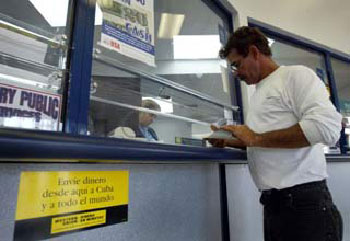Exporting Work Force, an Age-Old Practice of Cuban Style Socialism
By Vicente Morin Aguado

HAVANA TIMES — On New Year’s, mother’s day or any other highlighted date on the calendar, there are long lines out in front of any of the almost 500 Western Union offices that have opened up in the country.
Odilon Molina, President of the multi-national company for the Americas, has stated that the total amount of transfers to Cuba was over 1.2 billion USD last year.
This figure widely exceeds net income from tourism because even though this recreational industry could generate three times more revenue, its earnings are calculated to be between 24 and 30 cents for every dollar according to assessments by several analysts including Cuban economist Omar Everleny.
However, the situation with Western Union is just a slice of the exporting of the country’s work force, not forgetting that almost half a million Cubans living on US soil visited their homeland in 2015, bringing remittances with them, in cash and in kind. As if that wasn’t enough, you have to also take into account contributions made by the Cuban diaspora in Europe and other countries.
The independent organization, The Havana Consulting Group, based in Miami, has taken this matter into their own hands and one of its executives, economist Emilio Morales, gave us the following figures which we will analyze:
– At the end of 2014, Cuban remittances just from the US were estimated to be 3.13 billion USD with an error margin that never exceeded 4%.
– The active working population in 2014 was 4.96 million. Simple math tells us that emigration created 629.7 USD for every Cuban “working” in the country where people don’t want to work. That translates into 16,100 Cuban pesos – CUP at the official exchange rate of 25 CUP for one Convertible Peso – CUC which is the equivalent of a dollar. That means, given the average salary of 584 CUP today = 7,008 CUP per year, the Cuban work force in the US has provided its birth place with more than double their fellow Cubans living on the island. Emigration is an excellent business.

Exporting the country’s work force isn’t by chance, nor is it the indirect consequence of the disagreement between the Cuban and US government. Back in the 1980s, under the blanket of the Council for Mutual Economic Assistance (COMECON), the now disappeared Socialist Bloc’s international economic body, the supervised sending of Cubans to Eastern Europe and the USSR was widely practiced.
Back then, people’s dreams were a little more modest, they could be realized in a German ETZ motorbike. Jealously kept and sold and resold, thousands of these bikes still travel along our streets. The large number of Cubans who watched the Berlin Wall fall (1989), took advantage of the opportunity and stayed in Europe permanently.
The sale of professional labor reached its climax via the so-called international missions, with public health and Cuban doctors being the focus. This subject was recently written about on Havana Times when dealing specifically with what happened in Venezuela.
In part of the interview Omar Everleny gave to the website 14 y Medio, he clearly stated what the Cuban economy’s sources of income were:
“Services first and foremost. However, payment for services in Venezuela must have decreased because of the latter’s own national crisis, we can estimate that the drop is around 1 billion USD from what was previously paid to Cuba [In 2012, it was estimated that the island earned 8.2 billion USD for medical services, possibly dropping by 1.3 billion today].”

Miami based Cuban economist Emilio Morales advances with figures of why the Cuban government exports its work force:
“If we compare the amount of remittances sent by Cuban emigres per capita with the annual average salary of the active working population in Cuba, (calculated using the official exchange rate – buying USD – at 24/1), the remittances of any ordinary emigre are worth 9.55 annual wages of Cuban workers.”
With regard to medical services, it’s worth remembering that the academic Carmelo Mesa Lago calculated that in the case of Venezuela, at least 10,000 Euros of monthly income is paid per Cuban worker, out of which the State monopoly directly takes between 70-90% leaving the “missionaries” hired in this way without the means to complain.
The final conclusion is simple: incapable of building a productive economy in their own country, the leaders of the Cuban socialist project found a way to market their citizens, via emigres or government to government projects, so their authoritarian system can receive the corresponding benefits where the right to oppose such policy is very limited.

You have developed an educational system that results in your professionals being poached & being gainfully employed all over the world & you’re complaining?
It is a beggar nation. Shameless are all those that support enslavement of Cuban people to indulge fantasy of Socialism. The socialist model as employed in Cuba is a failure. Fidel Castro was a disaster for millions of Cuban’s. Raul is making changes, but not fast enough. Now that FC gone, he has more freedom to accelerate reforms along Vietnam model. If he fails, the regime will fall as the people have had enough.